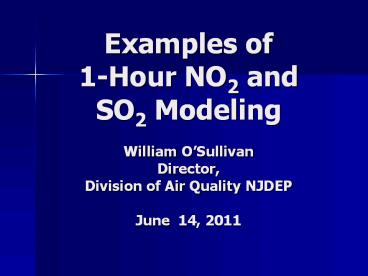Examples of 1-Hour NO2 and SO2 Modeling William O PowerPoint PPT Presentation
Title: Examples of 1-Hour NO2 and SO2 Modeling William O
1
Examples of 1-Hour NO2 and SO2 ModelingWilliam
OSullivanDirector, Division of Air Quality
NJDEPJune 14, 2011
2
1-Hour NO2 ModelingLS Power West Deptford
Station
- 600 MW Combined-Cycle Plant
- Natural gas with 0.05 sulfur oil backup
- Stack Heights
- turbines 64 meters
- emergency generator 38.1 meters
- emergency fire pump 15.2 meters
3
Scenarios of Interest
- Normal Operations (NOx ng 37 lb/hr)
- (NOx oil 70
lb/hr) - Startup Operations (NOx 223 lb/hr)
- Emergency Equipment generator (NOx 10 lb/hr)
and fire pump (NOx - 1.3 lb/hr)
4
Modeling Was More Inclusive than Current EPA
Guidance
- Permit Conditons to Avoid 1-Hour NAAQS Problems
- Emergency generator had to raise stack
- Testing of emergency generator and fire pump
not allowed during turbine startup - Per EPAs March 1, 2011 guidance - emergency
generators and turbine startup may not need to be
modeled. - If they are, problems can be avoided with
reasonable measures.
5
8th high 1-Hour NO2 Impacts(75 NOx to NO2
conversion assumed)
- Normal Operations (oil) 8.1 ug/m3
- Startup Operations (223 lbs/hr) 42 ug/m3
- Emergency Equipment(11.3 lbs/hr) 43 ug/m3
- Lesson Short stacks cause big impacts!
- (1-hour NO2 NAAQS 189 ug/m3)
6
Red Receptors - Impacts above 1-hr NO2
Significance Level during Normal Operations
7
Red Receptors - Impacts above 1-hr NO2
Significance Level during Startup Operations
8
Existing Sources
- Did not consider impacts of existing off-site
emergency generators - May require higher stacks on diesel engines near
sensitive receptors (hospitals) independent of NSR
9
SO2 Modeling of a 400 MW Power Plant
10
(No Transcript)
11
(No Transcript)
12
Power Plant Description
- Size/Age
- Unit 1 160 MW / 1958
- Unit 2 240 MW / 1962
- No existing emission controls for SO2
- 2007 2010 annual average emissions of 29,067
tons
13
SO2 Modeling Conducted with Two EPA Models
- 1. AERMOD (guideline model)
- 2. CALPUFF (complex terrain model)
- May be applied at locations with complex local
winds generated by terrain variations. - Must conduct a model validation that shows it
performs better for the given application than
EPAs preferred model (AERMOD).
14
Summary of CALPUFF Results 3-Hour SO2 NAAQS
(1300 ug/m3) no background included
Meteorological Time Period Emissions Days Violating NAAQS Over NAAQS
2002 Allowable 17 144
2002 Actual 2 54
15
(No Transcript)
16
Summary of CALPUFF Results 24-Hour SO2 NAAQS
(365 ug/m3) no background included
Meteorological Time Period Emissions Days Violating NAAQS Over NAAQS
2002 Allowable 6 28
2002 Actual (CEM data) 0 -21
17
(No Transcript)
18
Summary of CALPUFF Results 1-Hour SO2 NAAQS (75
ppb or 196 ug/m3) no background included
Meteorological Time Period Emissions Days Violating NAAQS Over NAAQS
2002 Allowable 39 1662 ( 17 x NAAQS)
2002 Actual (CEM data) 27 1019 ( 10 x NAAQS)
19
M
M
m
20
Summary of AERMOD Results 1-Hour SO2 NAAQS (75
ppb or 196 ug/m3) no background included
Meteorological Time Period Emissions Days Violating NAAQS Over NAAQS
1993-94 Allowable 42 615 ( 6 x NAAQS)
1993-94 Actual (avg. monthly) 5 138 ( 1.4 x NAAQS)
No predicted violations of the 3-hour or 24-hour
NAAQS
21
(No Transcript)
22
Trajectory Analysis of High SO2 Episodes at Area
Monitors
- NOAAs HYSPLIT trajectory model based on weather
forecast model windfields - Chester SO2 Monitor located 21 miles east of
Portland Power Plant - Columbia Lake Monitor located 1.2 miles northeast
of Portland Power Plant
23
HYSPLIT Trajectory Analysis of Chester Monitor
High SO2 Episode
- Hourly SO2 values measured July 17, 2008 10pm -
77 ppb, 11pm - 85 ppb, 54 ppb midnight - CEM Emissions data July 17, 2008,
- Portland avg. hourly SO2 12,500 lbs
- (allowable 14,720 lb/hr)
24
- 6-hour trajectory starting at Portland at 4 pm
- blue line at 221 meter above ground,
- red line at 10 meters above ground.
25
HYSPLIT Trajectory Analysis of Columbia Lake
Monitor High SO2 Episode
- Data collected at Columbia Lake Monitor since
Sept. 23, 2010 - 14 exceedances of the 1-hour SO2 NAAQS of 75 ppb
(196 ug/m3) recorded from Sept. 23, 2010 to April
17, 2011
26
(No Transcript)
27
Columbia Lake - Sept. 23, 2010 to Feb. 17, 2011
28
HYSPLIT Trajectory Analysis of Columbia Lake
Monitor October 30, 2010 Episode
- 183 ppb hourly SO2 values measured at 8 pm was
highest value monitored so far (2.5 x NAAQS ) - CEM Emissions data Hours 7 and 8 pm,
- Portland P.P. avg. hourly SO2 6,500 lbs
(allowable of 14,720 lbs/hr) - Martins Creek P.P. avg. hourly SO2 0 lbs
29
October 30, 2010 Episode
1-hr NAAQS of 75 ppb
30
- 1-hr trajectory starting at 7pm
- green line at 221 meter above ground (plume
height), - blue line at 100 meters above ground,
- red line at 10 meters above ground.
31
Conclusions
- SO2 1-Hour NAAQS is much more easily violated
than the 3 and 24-Hour NAAQS - Columbia Lake monitoring confirms both CALPUFF
and AERMOD predictions of 1-hour NAAQS violation
at that location - Model Validation study showed CALPUFF performs
better at this location

